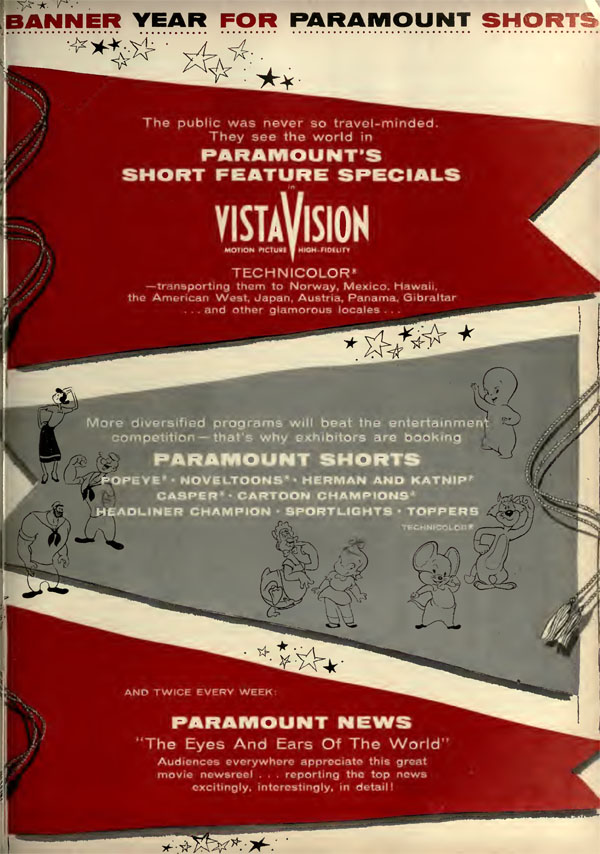
ABOVE: The Paramount Shorts trade advertisement published in October 1956 – no longer acknowledging Famous Studios
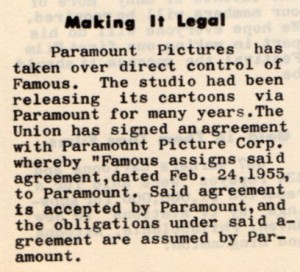
A notice in the October 1956 cartoonist union newsletter, TOP CEL, informing its members of Paramount’s takeover of Famous – and that Paramount would honor Famous Studios 1955 agreement with the union.
Kneitel and Sparber really had no choice but to comply. Paramount summarily ordered the number of subjects reduced to 16 pictures annually and, in the first week of January 1957, told Kneitel to layoff 20 staff members – including Izzy Sparber. Before the month was over key personnel, such as Dave Tendlar and Myron Waldman, departed (Tendlar went to Terrytoons, Waldman joined forces with Hal Seegar).

The Wall Street Journal makes note of Paramount’s sell off of their cartoons in this April 4th 1957 clipping.
The backgrounds, in particular, are outstanding examples of minimalist design, with vivid colors (especially if viewed in Technicolor). The “Scenics” crew of Robert Owen, Robert Little and John Zago were now unshackled – and became inspired, adding a fresh contemporary feel to the previously tired Famous material. Take another look at the background paintings in Fishing Tackler (Zago) or Spooking About Africa (Owens) – this is good stuff.
Character designs were also modified during this period as well. A more angular style was adopted for the stars Popeye, Herman and Katnip, even Baby Huey. Overall, the theatrical films became more attractive. It’s too bad no one really noticed.
 By January 1957 the “Famous Studios” name had virtually disappeared. Spooking About Africa (1/4/57) still bears an on-screen title card “A Famous Studios Production” but it may have been the last cartoon to do so (a re-designed Famous screen-credit began appearing on the 1955-56 releases).
By January 1957 the “Famous Studios” name had virtually disappeared. Spooking About Africa (1/4/57) still bears an on-screen title card “A Famous Studios Production” but it may have been the last cartoon to do so (a re-designed Famous screen-credit began appearing on the 1955-56 releases).
Paramount itself seemed ambivalent about the name of the new division of the company. It was listed simply as the ‘Paramount Pictures Cartoon Studios’ in-house – and on rare screen credits, usually when the studio did work-for-hire (for Harvey Comics or King Features).
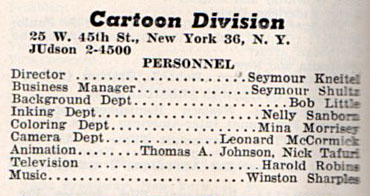
From the 1958 Film Daily Yearbook, reflecting the 1957 personnel of the Paramount Pictures “Cartoon Division”
Let’s take a look cartoons released during at the 1956-57 season. Casper was still enjoying his popularity on screen and in Harvey Comics – and Herman and Katnip were still viable, especially as MGM was winding down its Tom & Jerry series. The Noveltoons ambled along with a fresh Little Audrey and Baby Huey pictures; Tommy Tortoise and Moe Hare seemed to fill the bill from the now un-PC Buzzy Crow. Of the new characters, Louis The Lion was clearly pointed at kids, while Sir Irving and Jeames were geared towards the grown ups. Renoir the Matchmaker seemed to click and would be used again in subsequent seasons.
This would be the last season for newly produced Popeye The Sailor theatricals. AAP began distributing the Popeye cartoons to television in the Fall of 1956 and they were an immediate hit. In fact, Popeye was biggest thing in kids TV that year – and the next, and maybe for the next ten years.
Paramount had retained the rights to reissue the older cartoons for the next ten years – and that allowed the studio to have its cake and eat it too. It could still sell a package of shorts to theaters each year with their biggest “star” attached. And, thanks to King Features, Popeye himself would go on and on – with television cartoons and on children’ records, providing story man and voice actor Jack Mercer an income for life.

Eight (8) POPEYE cartoons
PARLEZ VOUS WOO (9/12/56) Sparber/Eugster. UPA stylization takes over in this parody of TV’s The Continental. Bluto impersonates “The International”, a suave French talking TV charmer, to woo Olive away from Popeye.
I DON’T SCARE (11/16/56) Sparber/Johnson. Bluto uses Olive’s fear of superstitions to scare her away from Popeye.
A HAUL IN ONE (12/14/56) Sparber/Eugster. A remake of Fleischer’s Let’s Get Movin’ – Moving Men Popeye and Bluto compete to win Olive’s favor.
NEARLYWEDS (2/8/57) Kneitel/Johnson. The first Paramount Popeye cartoon without a credit title for Famous Studios since Alona Of The Sarong Seas (1942). Olive accepts Popeye proposal of marriage and Bluto does everything to ruin those plans.
THE CRYSTAL BRAWL (4/5/57) Kneitel/Eugster. In this cheater, an angular-stylized Bluto takes Olive to a fortune teller who shows her stock clips from the traditionally drawn Alpine For You and Quick On The Vigor.
PATRIOTIC POPEYE (5/10/57) Sparber/Johnson. Popeye warns his two nephews about the dangers of illegal fireworks.
SPREE LUNCH (6/21/57) Kneitel/Johnson. Restauranteurs Popeye and Bluto compete for the patronage of a customer, Wimpy.
SPOOKY SWABS (8/9/57) Sparber/Johnson. The final Paramount theatrical Popeye cartoon is sort-of a remake of Fleischer’s Shiver Me Timbers. A shipwrecked Popeye and Olive (who wants to “go home and watch television”) encounter a haunted old sailing ship, loaded with British ghosts.

An ad from the L.A. Times 5/29/57 which lists “Patriotic Popeye” being shown in VistaVision!
Six (6) Noveltoons
SIR IRVING AND JEAMES (10/19/56) Kneitel/Eugster. Thick outlines, stylized design, odd story (by Irv Spector) about a rich, pampered mustachioed dog and his harried butler Jeames, who only wants to discuss his pension.
LION IN THE ROAR (12/21/56) Kneitel/Eugster. Louis The Lion practices for his future role as King of The Jungle.
PEST PUPIL (1/25/57) Tendlar/Reden. (Baby Huey) Huey gets expelled from kindergarden and requires a private tutor.
FISHING TACKLER (3/29/57) Sparber/Golden. (Little Audrey) A truant officer follows Audrey on her fishing trip.
MR. MONEY GAGS (6/7/57) Sparber/Eugster. (Tommy Tortoise and Moe Hare) Tommy goes to the big city and runs into Moe the Gyp (Moe Hare).
L’MOUR THE MERRIER (7/5/57) Kneitel/Eugster. Renoir the Matchmaker tries to match Hector the Garbage collector with the Princess Louise.

Model Sheet of the Tutor from “Pest Pupil”
Four (4) Herman & Katnip cartoons
HIDE AND PEAK (12/7/56) Tendlar/Reden. Herman and Katnip go mountain climbing.
CAT IN THE ACT (2/22/57) Tendlar/Reden. Herman tours his nephews around Paramount Pictures, unaware that Katnip is the night watchman.
SKY SCRAPPERS (4/14/57) Tendlar/Reden. Herman finds his cousins a new place to live, on a construction site unaware that Katnip is the watchman.
FROM MAD TO WORSE (8/16/57) Kneitel/Johnson. In a department store, Herman plots to drive Katnip crazy.
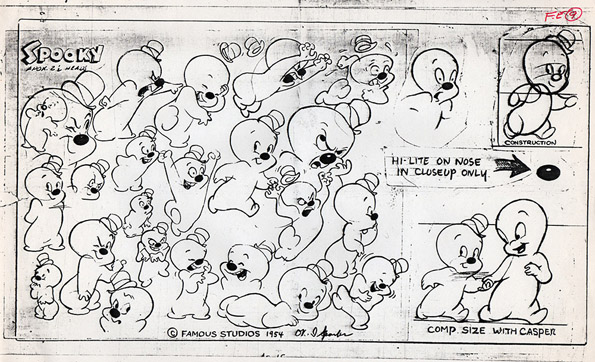
Model Sheet for Spooky (dated 1954) used for “Hooky Spooky” released in 1957.
Six (6) Casper cartoons
FRIGHT FROM WRONG (11/2/56) Kneitel/Golden. The Ghostly Trio give Casper a “mean pill” which turns him into a little devil.
SPOOKING ABOUT AFRICA (1/4/57) Kneitel/Waldman. I believe this may be the last cartoon to carry a “Famous Studios” title card. Casper helps Wheezy The Elephant get rid of bad sneeze.
HOOKY SPOOKY (3/1/57) Kneitel/Waldman. Cousin Spooky is scaring all the animals instead of going to school.
PEEK-A-BOO (4/24/57) Kneitel/Waldman. Casper plays with a mischievous kitten who is tormenting a dog.
GHOST OF HONOR (7/19/57) Sparber/Waldman. At a Hollywood premiere, Casper tells a reporter of how he became a star. The lush Paramount Animation Studios pictured in this film looked nothing like the actual studio in New York’s Times Square. Baby Huey, Herman and Katnip, Spunky Donkey, Tommy Tortoise and Moe Hare make cameo appearances.
ICE SCREAM (8/30/57) Kneitel/Waldman. Casper pretends to be a snowman to teach Little Billy how to skate.
(Special thanks this week to Ken Layton, Art Binninger, Fred Grandinetti and Thad K)


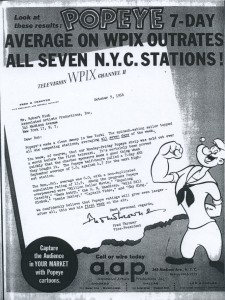

 Jerry Beck is a writer, animation producer, college professor and author of more than 15 books on animation history. He is a former studio exec with Nickelodeon Movies and Disney, and has written for The Hollywood Reporter and Variety. He has curated cartoons for DVD and blu-ray compilations and has lent his expertise to dozens of bonus documentaries and audio commentaries on such. Beck is currently on the faculty of Cal Arts in Valencia, UCLA in Westwood and Woodbury University in Burbank – teaching animation history. More about Jerry Beck [
Jerry Beck is a writer, animation producer, college professor and author of more than 15 books on animation history. He is a former studio exec with Nickelodeon Movies and Disney, and has written for The Hollywood Reporter and Variety. He has curated cartoons for DVD and blu-ray compilations and has lent his expertise to dozens of bonus documentaries and audio commentaries on such. Beck is currently on the faculty of Cal Arts in Valencia, UCLA in Westwood and Woodbury University in Burbank – teaching animation history. More about Jerry Beck [



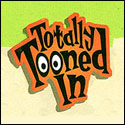



Hi Jerry,
What was the name of the Herman & Katnip cartoon which spoofs ‘This is Your Life’? It starts off with Katnip chasing Herman and then Katnip runs into this tv host who shows him an audience of ‘your favourite cartoon characters’ (none of which I recognised). I remember watching it on tv when I was 7 or 8,I’ve never seen it since.
That was KATNIP’S BIG DAY, the last short in the series from 1959.
That would be Katnip’s Big Day – the final Herman and Katnip release in 1959. We’ll mention that one in two weeks or so.
Thank you.
The TV series “The Continental” parodied in “Parlez-vous Woo” starred Renzo Cesana as a suave European gigolo-type who addressed the camera as if it were his date. It was also spoofed in the Pepe Le Pew cartoon “The Cat’s Bah.”
I remember the Pepe Le Pew cartoon. Because I had never heard of ‘The Continental’,I was wondering what Chuck Jones was parodying in it.
For a short-lived TV show, “The Continental” stuck in cultural memory for a long time. The 50’s Mad Comic parody “The Countynental” has persevered through reprints, Christopher Walken did a series of parodies on “Saturday Night Live,” and I could swear I saw a “Flintstones” in Fred disgustedly turned of a TV set showing the Continental character, but I can’t track down the title.
It’s a shame Paramount couldn’t have held its budgets/design position at this level. The Eugster unit’s use of the UPA stylings were particularly effective this season, because there was still enough money to move the characters from more fluid animation into the new angular style and get that to register as effective ‘takes’, something Famous’ dull timing of the early 1950s had pretty much eliminated. Olive going full-UPA on the audience when she sees Bluto chasing her on the boardwalk in “The Crystal Brawl” and M. Renoir with his breaking of the fourth wall at the start of “L’Mour the Merrier” are two particular examples of using abstract stylization to get funny poses on a limited budget. But they weren’t as effective once all the animation became limited starting in the 1957-58 season. (Ginny Mahoney’s initial post on her blog about her dad Seymour showed the hall art from this period, and you can definitely tell which character poses came from the Eugster unit and which did not by the UPA influence)
The more adult directed tone of Spector’s Noveltoons also seemed to mirror the type of one-shot cartoons Warner Bros. was doing at the time, only in a darker tone (which would get even darker in the ’57-58 season), to the point that the Modern Madcaps apparently were born originally in order to have a specific place to put the less ‘child-friendly’ cartoons, while the Noveltoon umbrella would be stories more designed for the kiddos (a difference that would go out the window by 1964).
“Cartoon Champions” reissues for the 1956-57 season. Interesting that while Buzzy was no longer eligible to star in new cartoons, Paramount didn’t object to reissuing his old ones.
“Mice Meeting You”
“Sock-a-Bye Kitty”
“Casper’s Spree Under the Sea”
“One Quack Mind”
“Mice Paradise”
“Once Upon a Rhyme”
“Hold the Lion Please”
“Land of Lost Watches”
“To Boo or Not to Boo”
“As the Crow Lies”
“Slip Us Some Redskin”
“Boo Scout”
Patriotic Popeye was the one about Popeye’s two nephews (don’t know whether it was either Pipeye and Poopeye or Peepeye and Pupeye) who wanted to have fireworks (the ones that are banned in some states, but legal in others – aka extreme or not considered “Safe and Sane”) for the Fourth of July. It’s similar to the MGM Tom & Jerry cartoon Safety Second (1950), where Nibbles (aka Tuffy) wanted to shoot off fireworks to celebrate the Fourth but Jerry (like Popeye in Patrotic Popeye) wanted a safer alternative.
RE: Fright From Wrong, one of the most insane Casper cartoons I’ve ever seen. Casper’s uncles, the so-called The Ghostly Trio, are tired of Casper’s “Goody Two Shoes” ways, and decide to dope the friendly ghost with some “Mean Pills”, forcing Casper to act like a meany. Somehow they gave him an overdose (or so it seems) and Casper becomes a little hellion – terrorizing his uncles, but just enough to teach his three uncles a valuable lesson: that being mean isn’t nice.
And on the model sheet for Spooky: it shows how Spooky was changed from his first appearance in Hide and Shriek from two years before, where Spooky was a scrawny little ghost with a oversized toboggan hat.
Also note the theme song from Casper the Friendly Ghost was changed into a instrumental theme instead of the usual song (with lyrics) that was part of the Casper cartoons in the first five years of the series.
Patriotic Popeye also was one of the sources for the Win Sharples music library….I wonder if Casper was a vocal song first then an instrumental as you said..
Thinking of Patriotic Popeye, thinking of how more sheltered kids are these days, Popeye’s solution at the end of this wouldn’t really be all that great either when you think about it (assuming parents are that tight).
“Patriotic Popeye” always seemed so wrong to me. Popeye, of all characters, preaching in favor of “safe and sane” (i.e., dull) fireworks? He seems more the type to get a stockpile of barely legal fireworks and put on a loud, colorful display for the whole neighborhood.
“Patriotic Popeye” always seemed so wrong to me. Popeye, of all characters, preaching in favor of “safe and sane” (i.e., dull) fireworks? He seems more the type to get a stockpile of barely legal fireworks and put on a loud, colorful display for the whole neighborhood.
Oh, he would! He’d let his nephews hold on to the report while blindfolded as he lights off them rockets for the neighbors to watch (and call up social services later).
Sharples began compiling his “stock music” scores [with Hal Seeger as a partner in packaging them] as early as 1952 (Popeye’s “Swimmer Take All” and Little Audrey’s “The Case of the Cockeyed Canary”}. In addition to “Patriotic Popeye” during this period, Sharples also gleaned cues from “Hooky Spooky”, “Peek-A-Boo”, and “Mr. Money Gags”.
Waiting to hear about “The Cat”, the suave pussycat with the Cary Grant voice. His origin cartoon had a studio head searching the world for a new star, then bumping into a stylish cat who does a showtune:
That’s more of an earworm for me than “Department d’Sanitaire”. I don’t remember the song or the tune being used in any of the succeeding The Cat cartoons.
I’m glad someone else out there remembers “the right kind of hat!” I can sing the last line of the chorus. 🙂 A Youtube search brings nothing, and a general google search brought me here.
It came us last night during an online cocktail hour when a few of us men started showing off our very stylish hats. One other person remembered the song, another thought it was sung by Snagglepuss or Huckleberry Hound character, but the Cary Grant voice was distinctive.
There’s one less hallucination to worry about. Thank you.
Oh yeah, “FRIGHT FROM WRONG” was a strange cartoon that I remember seeing constantly, but what year is a POPEYE cartoon called “ACE OF SPACE”? I know there was a title, “POPEYE, THE ACE OF SPACE”, but there was also “ACE OF SPACE” in which Popeye has to deal with little green figures who talk in reverse. When I was on Cartoon Network, I identified it as, simply, “ACE OF SPACE”.
Have a look two seasons ago for that one: https://cartoonresearch.com/index.php/famous-studios-1953-54/
“Ace of Space” is the title of one of the TV Popeyes made by Larry Harmon. Unfortunately the only watchable version on YouTube has had the opening titles cut off:
https://www.youtube.com/watch?v=EUHcGKpRXxw
Here’s a silent B & W home movie print that has the opening titles:
https://www.youtube.com/watch?v=l-0V0RsMW8U
@ Bobby Bickert
That version of Popeye came out in 1960 about seven years after the original (full title -Popeye the Ace of Space came out on 1953.